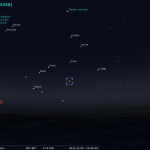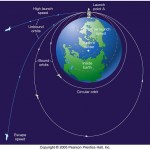black hole
The Aspen Center for Physics organizes weekly public lectures durings its winter conferences and its summer workshops.
This week the public lecture was by Roni Harnik of Fermilab on “The Higgs Boson and the Mystery of Mass.” The lectures are videoed by Aspen Grassroots television, and archived, and are very slowly being added to the Aspen Physics youtube channel.
This winter, Prof. Andrea Ghez, UCLA gave one of the public lectures at the Wheeler Opera House in Aspen: "The Monster of the Milky Way", on the central supermassive black hole in our galaxy.
Once again, there are three new pieces online on our website, each wonderful in its own way. But Haiku just didn’t seem to fit this batch. So, with apologies to the scientists, here are three limericks on the newest Institute research. As before, follow the links to get to our website.
(Incidentally, there is some precedent for limerick writing at the Weizmann Institute. The late Prof. Amikam Aharoni, who also wrote some serious stuff on ferromagnetism, was known for his limericks.)
The Quasar
There once was a baby black hole
That went for a short little stroll
It zigged and it zagged…
Today's guest post is by Weizmann Institute physicist, Prof. Micha Berkooz. Berkooz, a string theorist, recently organized a conference at the Institute on "Black Holes and Quantum Information Theory." We asked him about Hawking's recent proposal, reported in Nature under the headline:"There are no black holes."
Celebrated theoretical physicist Stephen Hawking has opened a can of worms in his 1976 paper on black holes. In a recent article, he is trying to put the worms back into the can. It may prove a little trickier than expected.
Black holes are solutions of Einstein's equations of…
"It is by going down into the abyss that we recover the treasures of life. Where you stumble, there lies your treasure." -Joseph Campbell
Ever since we created a question/suggestion box here, we've been deluged by far more excellent questions than one person could possibly answer, but that doesn't mean we aren't trying! For this week's Ask Ethan, our question comes from long-time fan and reader crd2, who asks:
As we look at the furthest quasars we see they have supermassive black holes, as large as 109 solar masses. By what mechanism are they able to reach such large sizes over so short…
"The proverb warns that 'You should not bite the hand that feeds you.' But maybe you should, if it prevents you from feeding yourself." -Thomas Szasz
But on this Messier Monday, you're lucky enough that you're about to be introduced to one of the great northern galaxies of the Messier catalogue that is feeding itself! There are 110 deep-sky, non-transient objects that make up the Messier catalogue, and a full 40 of them are galaxies, the most numerous and most distant of all the types of objects catalogued by Messier.
Image credit: Tenho Tuomi of http://www.lex.sk.ca/astro/messier/…
"Dream no small dreams, for they have no power to move the hearts of men." -Johann Wolfgang von Goethe
Welcome back to yet another Messier Monday here on Starts With A Bang! Each Monday, we highlight one of the 110 deep-sky objects that make up the Messier catalogue, showing you where and how to find it in the sky and telling you a bit about the history and the physics/astrophysics behind it. Each one tells its own unique story, and today's distant wonder is no exception.
Image credit: Rich Richins, of all 110 Messier objects (in no particular order).
On a virtually moonless night like…
“You wait for a gem in an endless sea of blah.” -Lawrence Grossman
On the one hand, we have General Relativity, our theory of space, time, and gravity.
Image credit: Wikimedia commons user Johnstone; Earth from NASA's Galileo mission.
It describes the Universe on both large and small scales perfectly, from the hot Big Bang to our cold accelerating expansion, from vast superclusters of galaxies down to the interiors of black holes.
Image credit: NASA, ESA, M. Postman (STScI), and the CLASH Team.
But General Relativity doesn't tell us everything. It doesn't tell us, for example,…
"According to the special theory of relativity nothing can travel faster than light, so that if light cannot escape, nothing else can either. The result would be a black hole: a region of space-time from which it is not possible to escape to infinity." -Stephen Hawking
You may have encountered objects that are the same size as one another, but have very different masses.
Image credit: Basic Science Supplies / © Accelerate Media.
This is because they're made out of different elements. The higher you go in the periodic table, the larger and more massive your individual atoms are, and so…
"There is a single light of science, and to brighten it anywhere is to brighten it everywhere." -Isaac Asimov
One of the most spectacular and successful ideas of the 20th Century was Einstein's General Relativity, or the idea that matter and energy determines the curvature of spacetime, and the curvature of spacetime in turn determines how gravitation works.
Image credit: Hyper-Mathematics - Uzayzaman / Spacetime.
From the orbits of planets to the bending of starlight, General Relativity governs all gravitational phenomena in the Universe, and accurately describes every observation we've…
"Everyone must leave something behind when he dies, my grandfather said. A child or a book or a painting or a house or a wall built or a pair of shoes made. Or a garden planted. Something your hand touched some way so your soul has somewhere to go when you die, and when people look at that tree or that flower you planted, you're there." -Ray Bradbury
Today is Memorial Day here in the United States, where we honor all the soldiers who have fought and fallen for our country. The peace and prosperity that I have enjoyed my entire life is because of a price paid, many times over, mostly by people…
We know, more or less how supernovae work. We've seen them just hours after they first go off through telescopes and satellites. The Crab Nebula, also known as M1, was a supernova that went off nearly 1,000 years ago in our own galaxy, for example, and we can simulate pretty well that it formed like this:
But this is totally new: a paper is coming out in the journal Nature tomorrow (the 22nd of May), where they've caught a star exploding red-handed!
First things first; here's a quicktime movie of the explosion. Let's put up some screenshots of the Blue Giant star before the explosion:
Here'…
The one-year anniversary edition of the Carnival of Space is up at Why Homeschool? If only more homeschoolers were into space, Astronomy, and science in general, the United States would be a far superior place, I'm sure!
Thanks to Henry Cate for starting the Carnival and coming back to host it one year later! My post on a black hole getting kicked out of our galaxy is up there; check it out and find out what's going on in outer space!
No, not because it was too young to drink! Scientists at the Max Planck Institute for Extraterrestrial Physics were looking at some X-ray objects, and discovered something really weird: a very bright X-ray source moving out of a galaxy at nearly 3,000 kilometers/second! This thing is a goner. If our Sun were moving at even one quarter of that speed, it would get thrown out of our galaxy.
Now, here's the kicker: this isn't just any old object getting tossed out of a galaxy, it is a huge black hole! How huge? About 300,000,000 times the mass of our Sun. You read that number right: 300,000,000…
What's going to happen to all the stars in the Universe as they get older? Well, just as nothing can live forever, stars can't live forever also. Why? Because they run on fuel: burning hydrogen into helium, for example. When they run out of fuel, something's gotta give. Barbara Ryden reminds us of an excellent and appropriate quote by Dylan Thomas:
Do not go gentle into that good night.
Rage, rage against the dying of the light.
But what exactly happens to the star depends very sensitively on what the mass of the star is.
If you've got a tiny little star, less than about 40% of the mass of…
You and I have lived on planet Earth long enough to know that if you want to launch something into space, it needs to travel fast enough to escape the pull of Earth's gravity. Launch it with too slow of a speed, and it crashes back into Earth. Launch it with a little more speed, and you can send it into orbit (like a satellite). But launch it fast enough, and it can escape from Earth's gravity altogether. The speed to completely escape from Earth's gravity is pretty fast: about 11.2 km/s, or 7 miles per second!
Make something denser and more massive, and you'll have to go faster and faster…












